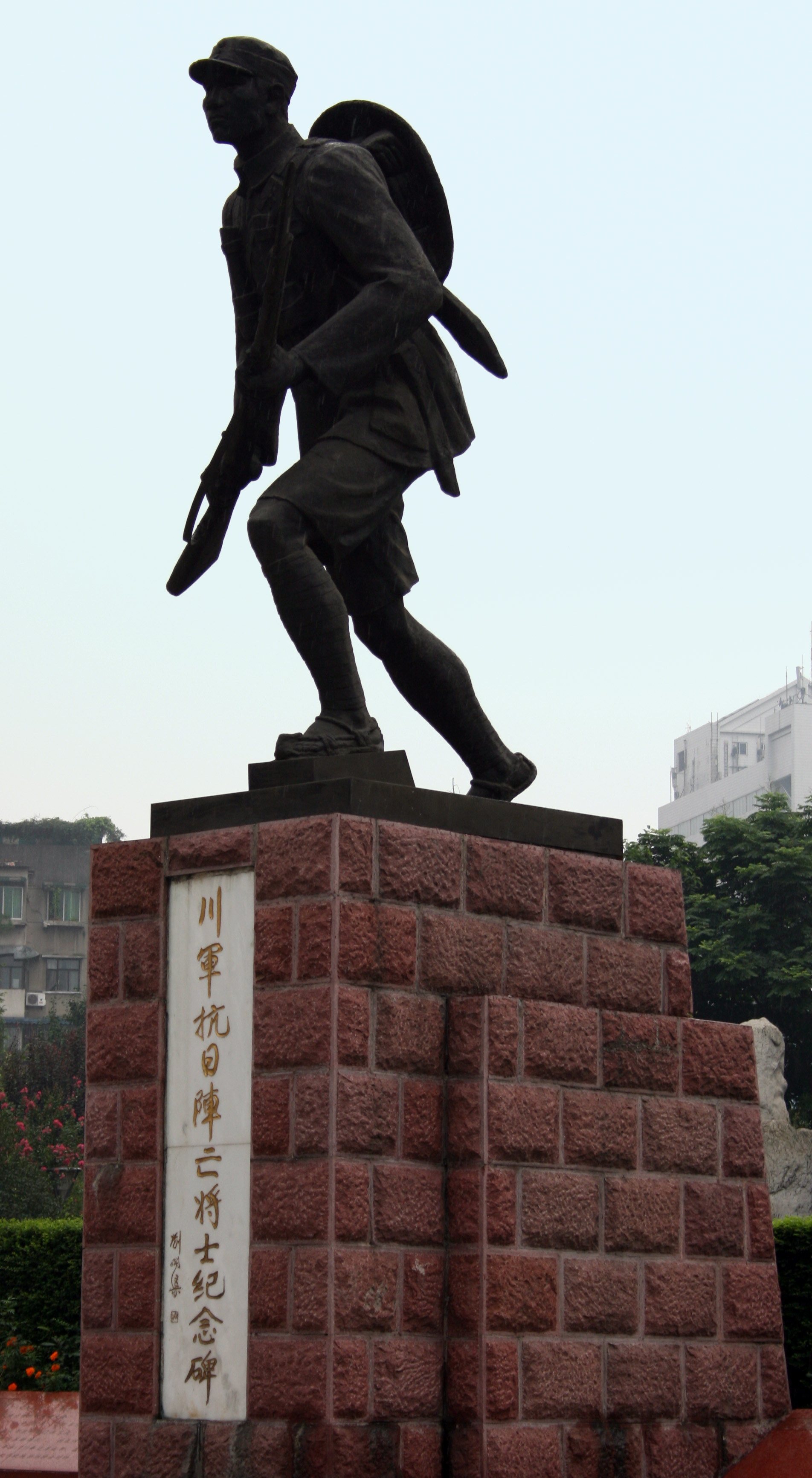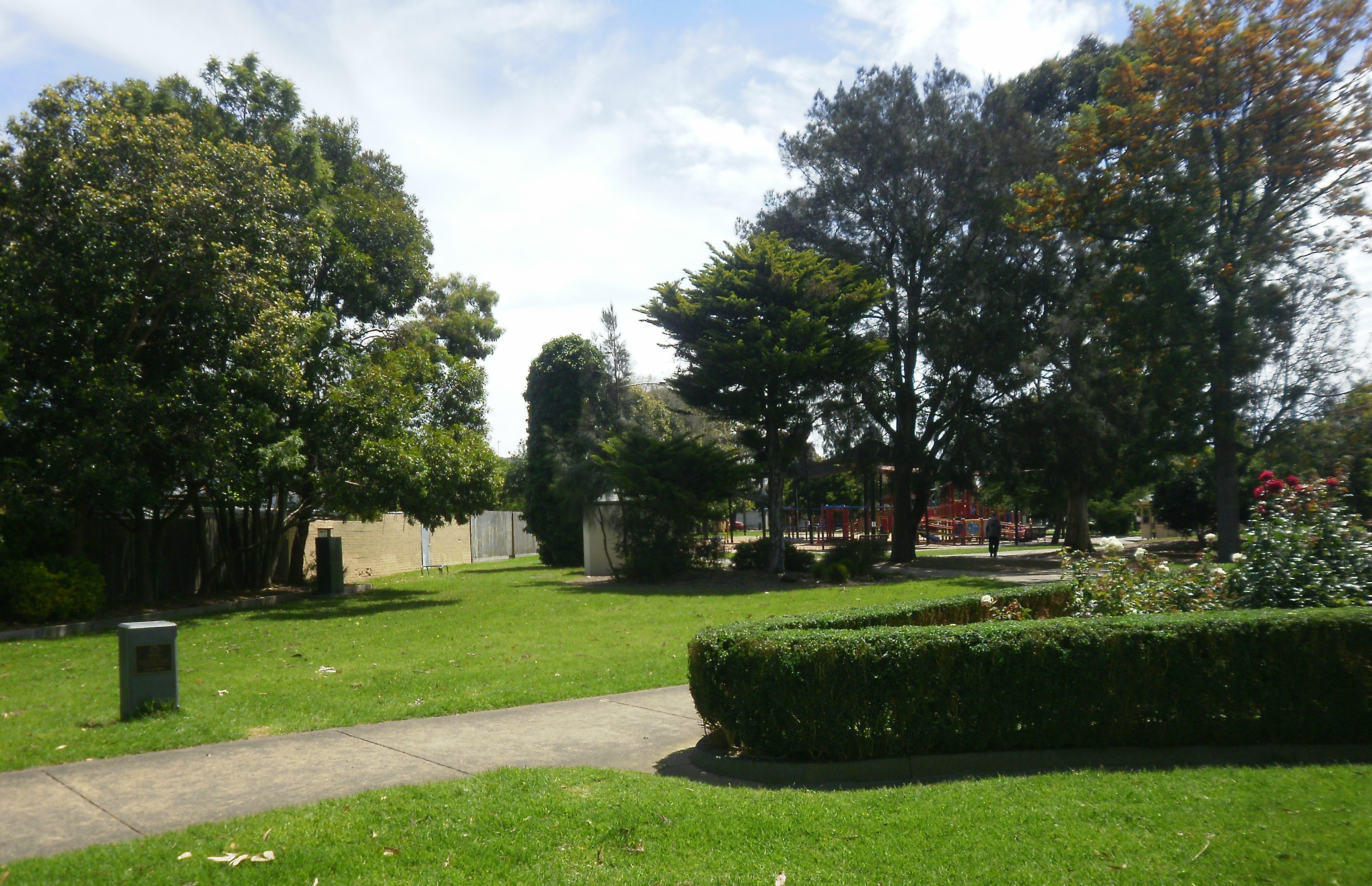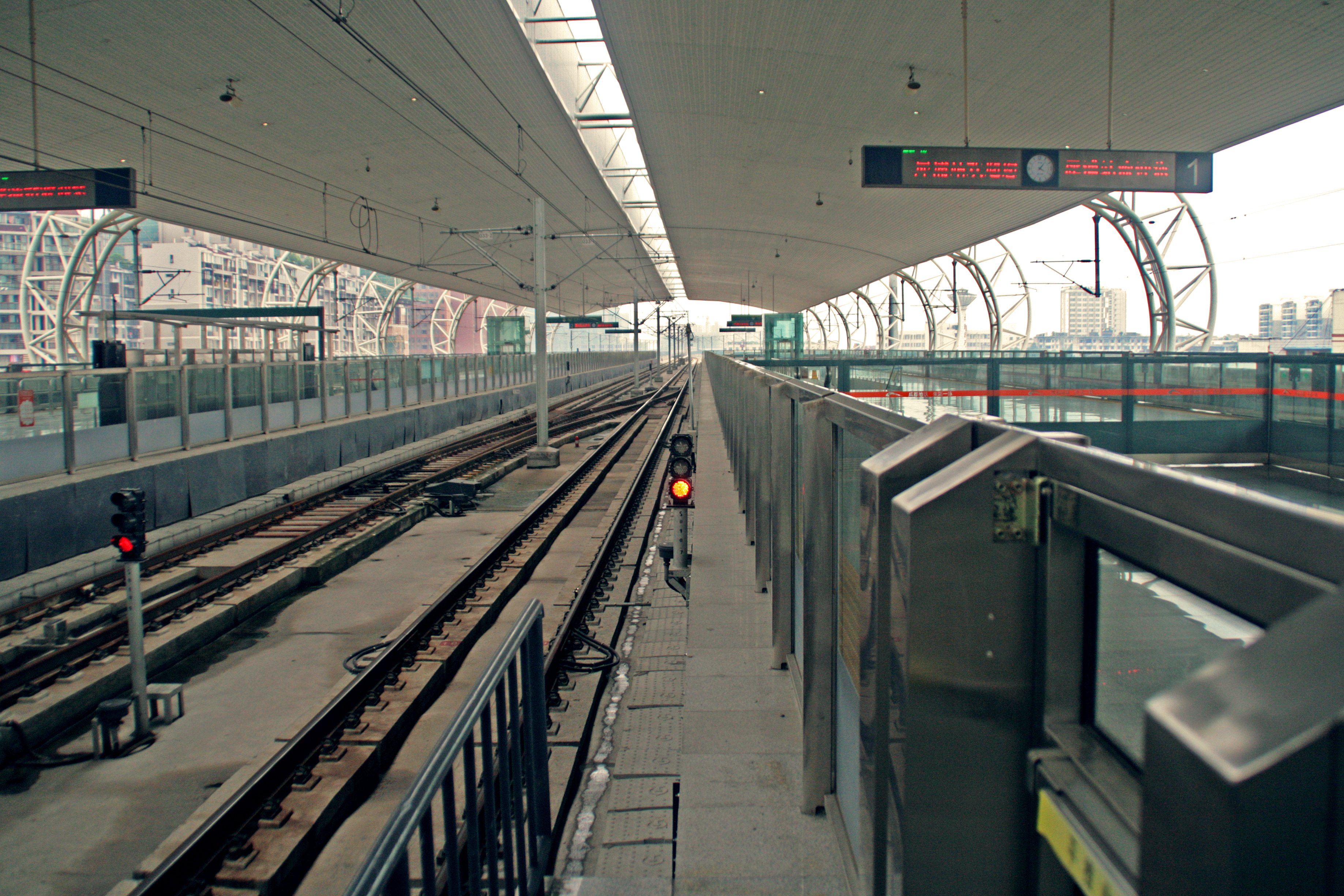|
People's Park (Chengdu)
People's Park () is an urban public park in central Chengdu, capital of Sichuan province, China. Built in 1911 as Shaocheng Park (少城公园), it is the first public park in the city. The Railway Protection Movement Monument in the park is designated a Major Historical and Cultural Site of China. Overview People's Park is located on Shaocheng Road in central Chengdu, near Tianfu Square. Covering an area of , it is the largest green area in downtown Chengdu. The park features an artificial lake, several gardens, the Railway Protection Movement Monument, and the century-old Heming Teahouse (), a local landmark. History The park is located in the former Shaocheng ("small city"), which was built by the Qing dynasty as the garrison for the Manchu and Mongol soldiers from the Eight Banners. In 1911, Yu Kun (玉昆), the last Qing general in Chengdu, converted part of Shaocheng into the city's first public park, known as Shaocheng Park. In 1911, the Railway Protection Movement erupte ... [...More Info...] [...Related Items...] OR: [Wikipedia] [Google] [Baidu] |
Railway Protection Movement
The Railway Protection Movement (), also known as the "Railway Rights Protection Movement", was a political protest movement that erupted in 1911 in late Qing China against the Qing government's plan to nationalize local railway development projects and transfer control to foreign banks. The movement, centered in Sichuan province, expressed mass discontent with Qing rule, galvanized anti-Qing groups and contributed to the outbreak of the Xinhai Revolution. The mobilization of imperial troops from neighboring Hubei Province to suppress the Railway Protection Movement created the opportunity for revolutionaries in Wuhan to launch the Wuchang Uprising, which triggered the revolution that overthrew the Qing dynasty and established the Republic of China. Background From the 1890s to 1905, nearly all railways in China were planned, financed, built and operated by foreign powers pursuant to concessions from the Qing government. To help local economies develop and retain earnings f ... [...More Info...] [...Related Items...] OR: [Wikipedia] [Google] [Baidu] |
Parks In Chengdu
A park is an area of natural, semi-natural or planted space set aside for human enjoyment and recreation or for the protection of wildlife or natural habitats. Urban parks are green spaces set aside for recreation inside towns and cities. National parks and country parks are green spaces used for recreation in the countryside. State parks and provincial parks are administered by sub-national government states and agencies. Parks may consist of grassy areas, rocks, soil and trees, but may also contain buildings and other artifacts such as monuments, fountains or playground structures. Many parks have fields for playing sports such as baseball and football, and paved areas for games such as basketball. Many parks have trails for walking, biking and other activities. Some parks are built adjacent to bodies of water or watercourses and may comprise a beach or boat dock area. Urban parks often have benches for sitting and may contain picnic tables and barbecue grills. The larg ... [...More Info...] [...Related Items...] OR: [Wikipedia] [Google] [Baidu] |
1911 Establishments In China
A notable ongoing event was the race for the South Pole. Events January * January 1 – A decade after federation, the Northern Territory and the Australian Capital Territory are added to the Commonwealth of Australia. * January 3 ** 1911 Kebin earthquake: An earthquake of 7.7 moment magnitude strikes near Almaty in Russian Turkestan, killing 450 or more people. ** Siege of Sidney Street in London: Two Latvian anarchists die, after a seven-hour siege against a combined police and military force. Home Secretary Winston Churchill arrives to oversee events. * January 5 – Egypt's Zamalek SC is founded as a general sports and Association football club by Belgian lawyer George Merzbach as Qasr El Nile Club. * January 14 – Roald Amundsen's South Pole expedition makes landfall, on the eastern edge of the Ross Ice Shelf. * January 18 – Eugene B. Ely lands on the deck of the USS ''Pennsylvania'' stationed in San Francisco harbor, ... [...More Info...] [...Related Items...] OR: [Wikipedia] [Google] [Baidu] |
Chengdu Metro
The Chengdu Metro is the rapid transit system of Chengdu, the capital of Sichuan, China. With the opening of Line 1 on 27 September 2010, the system consists of 12 subway lines and 1 light rail line. It has subsequently undergone rapid expansion. Since the opening of Lines 6, 8, 9, and 17 on 18 December 2020, the Chengdu Metro is the 4th longest metro system in the world. There are currently 12 operating subway lines totaling of track, and 1 tram line ( Line T2). The Chengdu Metro serves over 8 million trips per day. As of 2021, about 2.2 million and 4.6 million people live within of a subway station in Chengdu, respectively. Operating network There are twelve subway lines operated covering with 337 stations and a long with 36 stop light rail line ( Line T2) operating. Line 1 The first phase of Line 1 cost 7 billion yuan to construct. A natural ventilation system has been used in the underground section of Line 1 on the subway system from Southern Third Ring Ro ... [...More Info...] [...Related Items...] OR: [Wikipedia] [Google] [Baidu] |
Line 2, Chengdu Metro
Line 2 of the Chengdu Metro () is the second line on the metro network in Chengdu, Sichuan. Line 2 is a crosstown northwest-southeast trunk route. This line serves the Chengdu East railway station Chengdu East or Chengdudong railway station () is a railway station in Chenghua District, Chengdu, the capital of Sichuan province, serving the Chengdu–Chongqing intercity railway, the Chengdu–Guiyang high-speed railway, the Dazhou–Che .... Line 2 began operation on September 16, 2012. An 11 km long mostly elevated extension to Longquanyi began testing in April 2014 opened in October 2014. Opening timeline Stations Est. Completion References *''The information in this article is mostly based on that in its Chinese equivalent''. {{DEFAULTSORT:Chengdu Metro, Line 02 Chengdu Metro lines Railway lines opened in 2012 2012 establishments in China ... [...More Info...] [...Related Items...] OR: [Wikipedia] [Google] [Baidu] |
People's Park Station (Chengdu Metro)
People's Park station () is a station on Line 2 of the Chengdu Metro in China. It is located at the northwest corner of People's Park in Qingyang District, Chengdu Chengdu (, ; Simplified Chinese characters, simplified Chinese: 成都; pinyin: ''Chéngdū''; Sichuanese dialects, Sichuanese pronunciation: , Standard Chinese pronunciation: ), Chinese postal romanization, alternatively Romanization of Chi .... Station layout Gallery File:Entrance_B_of_People's_Park_Station.JPG, Entrance B File:成都地铁2号线人民公园站站厅层2.jpg, Concourse References Railway stations in China opened in 2012 Chengdu Metro stations {{Sichuan-railstation-stub ... [...More Info...] [...Related Items...] OR: [Wikipedia] [Google] [Baidu] |
Communist Party Of China
The Chinese Communist Party (CCP), officially the Communist Party of China (CPC), is the founding and sole ruling party of the People's Republic of China (PRC). Under the leadership of Mao Zedong, the CCP emerged victorious in the Chinese Civil War against the Kuomintang, and, in 1949, Mao proclaimed the establishment of the People's Republic of China. Since then, the CCP has governed China with eight smaller parties within its United Front and has sole control over the People's Liberation Army (PLA). Each successive leader of the CCP has added their own theories to the party's constitution, which outlines the ideological beliefs of the party, collectively referred to as socialism with Chinese characteristics. As of 2022, the CCP has more than 96 million members, making it the second largest political party by party membership in the world after India's Bharatiya Janata Party. The Chinese public generally refers to the CCP as simply "the Party". In 1921, Chen Duxiu and Li ... [...More Info...] [...Related Items...] OR: [Wikipedia] [Google] [Baidu] |
People's Republic Of China
China, officially the People's Republic of China (PRC), is a country in East Asia. It is the world's List of countries and dependencies by population, most populous country, with a Population of China, population exceeding 1.4 billion, slightly ahead of India. China spans the equivalent of five time zones and Borders of China, borders fourteen countries by land, the List of countries and territories by land borders, most of any country in the world, tied with Russia. Covering an area of approximately , it is the world's third List of countries and dependencies by area, largest country by total land area. The country consists of 22 provinces of China, provinces, five autonomous regions of China, autonomous regions, four direct-administered municipalities of China, municipalities, and two special administrative regions of China, Special Administrative Regions (Hong Kong and Macau). The national capital is Beijing, and the List of cities in China by population, most populous ci ... [...More Info...] [...Related Items...] OR: [Wikipedia] [Google] [Baidu] |
Battle Of Xuzhou
The Battle of Xuzhou was a military conflict between the Empire of Japan and the Republic of China forces in May 1938 during the Second Sino-Japanese War. History In 1937 the North China Area Army had chased Song Zheyuan's 29th Army to the south along the Jinpu Railway (see Tianjin–Pukou Railway Operation) after his defeat in the Battle of Lugou Bridge. After Japan won the Battle of Nanjing, the North China Area Army advanced southward to establish a Japanese connection between Beijing and Nanjing, ignoring the non-expansionist policy of the Imperial General Headquarters in Tokyo. Most mechanized and air forces in eastern China were wiped out in the Battle of Shanghai, which concluded in late November 1937. Although new equipment was purchased, it had yet to be shipped. Han Fuqu, the chairman of the Shandong province, rejected orders from Chiang Kai-shek and kept retreating to preserve his force. After Qingdao was occupied in January 1938, Han's policy was denounced and he wa ... [...More Info...] [...Related Items...] OR: [Wikipedia] [Google] [Baidu] |
Sichuan Army
The Sichuan clique was a group of warlords in the warlord era in China. During the period from 1927 to 1938, Sichuan was in the hands of five warlords: Liu Xiang, Yang Sen, Liu Wenhui, Deng Xihou, He Zhaode, and Tian Songyao, with minor forces being Xiong Kewu and Lü Chao. Introduction After Qing dynasty's collapse, not one warlord had enough power to take on all the others at once, so many small battles occurred, pitting one warlord against another. The Sichuan Clique was divided into smaller warlord groups, or Defense Zones, separated from each other with distinct military, political, and economic boundaries. Large conflicts seldom developed, plotting and skirmishing characterized the Sichuanese political scene, and ephemeral coalitions and counter-coalitions emerged and vanished with equal rapidity. However, Liu Xiang was the most influential of the Sichuan warlords. He controlled Chongqing and its surrounding areas. This region, sitting on the banks of the Yangtze riv ... [...More Info...] [...Related Items...] OR: [Wikipedia] [Google] [Baidu] |





